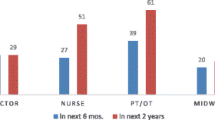Abstract
Latinos living in the USA account for one third of the uninsured population and face numerous cultural, linguistic, and financial barriers to accessing healthcare services. Community health fairs have developed to address the unmet need for no- and low-cost services that target prevention and education among underserved communities. The current research describes an ongoing effort in a community in Southern California and examines the barriers to health care among participants registering to receive free breast health screenings, one of the major services offered at a 2010 health fair. A total of 186 adult Latina women completed a brief questionnaire assessing their healthcare utilization and self-reported barriers to engaging in preventive and screening services. Approximately two thirds of the participants reported never receiving or having more than 2 years passing since receiving a preventive health check-up. Participants identified cost (64.5 %) and knowledge of locations for services (52.3 %) as the primary barriers to engaging in routine healthcare services. Engaging with health professionals represents a leading way in which adults obtain health information; health fairs offering cancer health screenings represent a culturally appropriate venue for increased cancer health equity. Implications of the current research for future health fairs and their role in community cancer education are discussed.
Similar content being viewed by others
Notes
The group was initially founded as the MANA in 1974, but has subsequently changed its name to MANA, A National Latina Organization, to better incorporate the group's mission to serve all Latinas.
References
Moonesinghe R, Zhu J, Truman B (2011) Health insurance coverage—United States, 2004 and 2008. Morbid Mortal Week Rep 60:35–37
Lucia L, Jacobs K, Dietz M, Graham-Squire D, Pourat N, Roby DH (2012) After millions of Californians gain health coverage under the Affordable Care Act, who will remain uninsured? UCLA Center for Health Policy Research, Los Angeles
Flores G, Vega LR (1998) Barriers to health care access for Latino children: a review. Fam Med 30:196–205
Rivers P, Patino F (2006) Barriers to health care access for Latino immigrants in the USA. Int J Soc Econ 39:207–220
Schur C, Albers LA, Berk M (1995) Health care use by Hispanic adults: financial vs. non-financial determinants. Health Care Financing Rev 17:71–88
Watts L, Naima J, Velazquez A, Gonzalez M, Munro E, Muzikansky A, Rauh-Hain JA, del Carmen MG (2009) Understanding barriers to cervical cancer screening among Hispanic women. Am J Obstet Gynecol 199:e1–e8
Zambrana R, Breen N, Fox S, Gutierrez-Mohamed ML (1999) Use of cancer screening practices by Hispanic women: analyses by subgroup. Prev Med 29:466–477
American Cancer Society (2011) Cancer facts & figures 2011. American Cancer Society, Atlanta
Oh S, Croft JB, Greenlund KJ, Ayala C, Zheng ZJ, Menash GA, Giles WH (2004) Disparities in premature deaths from heart disease—50 states and the District of Columbia. MMWR Morb Mortal Wkly Rep 54:121–125
Centers for Disease Control and Prevention (2010) Health disparities in HIV/AIDS, viral hepatitis, STDs, and TB: Hispanics and Latinos. http://www.cdc.gov/nchhstp/healthdisparities/Hispanics.html. Accessed 3 June 2011
Centers for Disease Control and Prevention (2011) National diabetes fact sheet: national estimates and general information on diabetes and prediabetes in the United States, 2011. U.S. Department of Health and Human Services, Centers for Disease Control and Prevention, Atlanta, GA
Maxwell A, Crespi C (2009) Trends in colorectal cancer screening utilization among ethnic groups in California: are we closing the gap? Cancer Epidemiol Biomark Prev 18:752–759
Kang-Kim M, Betancourt JR, Ayanian JZ, Zaslavsky AM, Yucel RM, Weissman JS (2008) Access to care and use of preventive services by Hispanics: state-based variations from 1991 to 2004. Med Care 46:507–515
Wells K, Roetzheim RG (2007) Health disparities in receipt of screening mammography in Latinas: a critical review of recent literature. Cancer Control 14:369–379
National Center for Health Statistics (2011) Health, United States, 2010: with special feature on death and dying. National Center for Health Statistics, Hyattsville, MD
U.S. Department of Health and Human Services (2013) America's health literacy: why we need accessible health information. http://www.health.gov/communication/literacy/issuebrief/#non. Accessed 2 June 2013
Aponte J, Nickitas DM (2007) Community as client: reaching an underserved urban community and meeting unmet primary health care needs. J Community Health Nurs 24:177–190
Dillon D, Sternas K (1997) Designing a successful health fair to promote individual, family, and community health. J Community Health Nurs 14:1–14
Dulin MK, Olive K, Florence J, Sliger C (2006) The financial value of services provided by a rural community health fair. J Health Care Poor Underserved 17:821–829
Leonardo M, Meyers MM, Kojsza D, Iagnemma J, Shapaka S (2002) The community health fair as an international health promotion and disease prevention strategy. Home Health Care Manag Pract 14:415–423
Mess S, Reese P, Lana DD, Walley A, Ives E, Lee M (2000) Older, hypertensive, and hypercholesterolemic fairgoers visit more booths and differ in their health concerns at a community health fair. J Community Health 25:315–329
California Department of Public Health (2011) Cancer detection programs: every woman counts. http://www.cdph.ca.gov/programs/cancerdetection/pages/cancerdetectionprogramseverywomancounts.aspx. Accessed 8 June 2011.
Guillemin F, Bombardier C, Beaton D (1993) Cross-cultural adaptation of health-related quality of life measures: literature review and proposed guidelines. J Clin Epidemiol 46:1417–1432
Abraído-Lanza AF, Chao MT, Gammon MD (2004) Breast and cervical cancer screening among Latinas and non-Latina whites. Am J Public Health 94:1393–1398
Valdez RB, Giachello A, Rodriguez-Trias H, Gomez P, De la Rocha C (1993) Improving access to health care in Latino communities. Public Health Rep 108:534–539
Acknowledgments
We would like to acknowledge the health fair planning committee organizations and providers and Venus Gines of Día de la Mujer Latina who supported the health fair in planning and implementation. This study was supported in part by the National Cancer Institute, Comprehensive Partnerships to Reduce Cancer Health Disparities Program, grants #1U54CA132384 and #1U54CA132379.
Author information
Authors and Affiliations
Corresponding author
Rights and permissions
About this article
Cite this article
Murray, K., Liang, A., Barnack-Tavlaris, J. et al. The Reach and Rationale for Community Health Fairs. J Canc Educ 29, 19–24 (2014). https://doi.org/10.1007/s13187-013-0528-3
Published:
Issue Date:
DOI: https://doi.org/10.1007/s13187-013-0528-3




